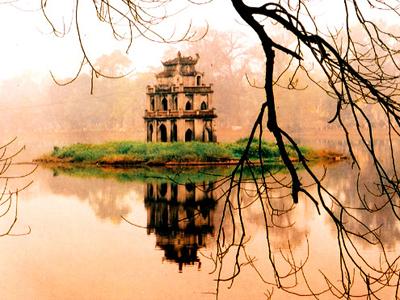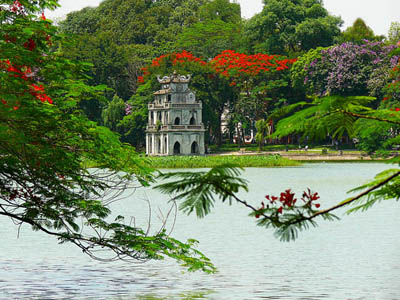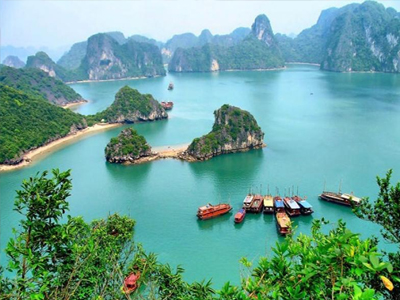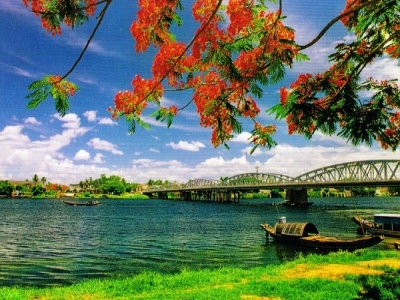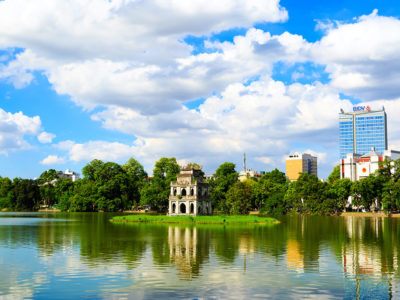Top Destinations in Laos
Located in the heart of Southeast Asia, Laos is a landlocked country known for its calm and peaceful atmosphere. Unlike its bustling neighbors of China, Vietnam, Thailand and Cambodia, Laos is a welcome break from much of Southeast Asia’s chaos. The country is made up mountains, rivers and waterfalls along with a plethora of Buddhist temples, all of which add to the serene natural beauty of the country. The Lao people also reflect an air of tranquility, with afternoon naps trumping business and comfort prioritized over rushing. This constant and contagious state of relaxation could be due to the fact that Laos has one of the least dense populations in Southeast Asia, with a population of only 5.4 million.
4000 Islands
4000 Islands, or Si Phan Dan, is an archipelago located within the Mekong Delta. Numerous islands dot the scenery, some small enough to be completely submerged in floods, others boasting entire towns and villages.
Must See
In Don Khon, one of the most popular islands to visit, stop by Tat Somphamit or Khon Phapheng to watch unrestrained rapids, or head to the southern tip of the island to do some dolphin spotting.
Must Do
In Don Khong, not to be mistaken with the similarly named ‘Don Khon’, discover Wat Jom Thong, the oldest temple on the island, and Wat Phuang Kaew, a temple thought to be constructed in the Chao Anou Period (1805 to 1828).
Go Local
In Don Khong, rise early to watch the bustling Muang Khong Market where you can find locals from all around floating in to sell their wares.
How To Get There
By Bus: It is most practical to travel to the southern islands from Pakse. A tourist bus can be organised with your travel agency or hotel, the ticket of which usually includes a short boat trip to your island of choice. These buses usually leave in the morning only.
Luang Prabang
Nestled in a valley between the Mekong and Nam Khan Rivers, Luang Prabang is a charming city filled to the brim with religious relics. The name itself translates to ‘Royal Buddha Image’ and the location, at the confluence of the two rivers, is considered sacred. Beyond the strong presence of Buddhism, there are many waterfalls, river cruises and mountain treks available.
Must See
Visit Ban Long Lao, a Hmong and Khmu village, is a top spot to see age-old tribes live their lives much like generations before did years ago.
Must Do
A visit to Ban Long Lao village can be combined with a 3 hour trek to Kuang Si Waterfalls, one of the most popular sights in Laos, which offers plenty of stunning scenery along the way.
Go Local
Visitors are welcome to take part in the daily alms giving, a sacred ritual in which the monks collect food from locals at sunrise.
How To Get There
By Plane: The local airport, Luang Prabang Airport, is small and simple with only a few flights running every day. Services run both domestically – from Vientiane and Pakse – and internationally – from Siem Reap, Hanoi, Bangkok and Chiang Mai.
By Bus: There are two bus stations in the city which respectively serve the north and the south of Laos.Kiew Lot Sai Nuan Station provides services to and from the north of the country whereas Naluang Station provides services in the south. Minibuses can also be arranged with your travel agency both nationally and internationally.
By Boat: Boats run from Huay Xai and the Thai border via Pakbeng. There is a choice of speedboat, slowboat or luxury cruise, the former of which is noisy but fast and the latter of which is slow but comfortable.
Muang Ngoi
What It Is
A truly rural and simplistic village with just one dusty road and a truly untouched river. Although Muang Ngoi is slowly building its infrastructure and facilities as tourism picks up, including permanent electricity and CLEAR road access, it is still a relatively simple destination. Surrounded by rice paddies, karsts and trekking trails, this is the perfect place to explore Laos by foot.
Must See
It’s tempting to hang out in a hammock all day in such a sleepy, serene town, and we’d recommend you do! A day relaxing in Muang Ngoi and watching the daily routine of the locals is arguably just as essential as some of the sights. We also recommend a trip to Kang Cave, a large, deep cavern once used as a refuge from American bombing raids.
Must Do
Trekking through the countryside is another must as the local scenery is filled with endless farmland and mountains, all of which seem to expand with every step away from the village centre.
Go Local
Visiting one of the hill-tribes is another great experience that shouldn’t be missed. We particularly recommend organizing a fishing trip with a local guide.
How To Get There
By Bus: There is a daily bus service from Luang Prabang which can be organised through your travel provider or hotel.
By Boat: Public boats run daily from Nong Khiaw and Muang Khua; they usually leave in the morning and take about 1 hour.
Nong Khiaw
What It Is
This rustic village is made up of two simple roads hidden within magnificent limestone mountains. The Nam Ou River winds around the small town, providing a view of daily fishing and farming, or an opportunity for a boat ride. Nong Khiaw successfully balances charming traditionalism with modern commercial tourism, preserving plenty of traditional homes and farmland while also providing modern accommodation with hot water and 24-hour electricity.
Must See
Visit a H’mong village to see how their traditions differ from those of the area’s other ethnic-minority groups.
Must Do
Stop by Pha Thor Cave to explore former government offices and a local hospital used during the Indochina War – you can even swim through some of the cave.
Go Local
Take a cruise to Ban Sopjam, lowlands home to around 70 families, and spend the night in a local homestay. Here you can learn how to make homespun silk and cotton with an old-fashioned loom.
How To Get There
By Bus: Nong Khiaw is easily accessible by a minibus from the Northern Bus Station in Luang Prabang. The journey takes about 3 hours and arrives at Nong Khiaw Bus Station, which is just a short walk from the village.
By Boat: Nong Khiaw can be reached from Muang Khua or Muang Ngoi by boat traveling down the Nam Ou River. The journey from Muang Khua takes approximately 6 hours whereas a trip from nearby Muang Ngoi only takes about an hour.
Pakse
What It Is
Pakse is the capital of Champasak, a southwestern province nearby the borders of Thailand and Cambodia, and has the second largest population in the country. Although the city is often considered more of a transit point than a destination, it definitely shouldn’t be overlooked. Pakse is arguably the entrance to the southern splendor of Laos with numerous attractions, trips and adventures only a day trip away.
Must See
History lovers shouldn’t miss Wat Phou, a UNESCO World Heritage Site that represents the easternmost border of the Khmer empire.
Must Do
Take a hike up to the Bolaven Plateau, through coffee plantations, over a hanging bridge, and on to the plains.
Go Local
Along with much of Laos, locals and foreigners can often be found soaking up the atmosphere near the rivers. Head to Xe Don River or the Mekong River to enjoy the scenery yourself.
How To Get There
By Plane: Both international and domestic flights head into Pakse International Airport, with flights regularly to and from Vientiane, Siem Reap, Bangkok and Ho Chi Minh City. The airport is based 8km outside of Pakse city centre and can best be reached by taxi or a pre-arranged transfer.
By Bus: Buses to and from Pakse are generally cheap and frequent with services operating from four different bus stations. Buses travelling between Pakse and Vientiane are likely to arrive and depart fromChitpasong Bus Terminal. Kriang Kai Bus Terminal operates international overnight journeys from Ubon Ratchatani or Bangkok. Whereas the Northern Bus Terminal and Southern Bus Terminal operate journeys respectively North and South of Pakse.
By Boat: There are no regular boat services to or from Pakse, there are only private or adhoc services which must be arranged with your hotel or travel agent. However, boats are often expensive and slow in comparison to other forms of transport.
Seuang River Village
What It Is
Located about three hours north of Luang Prabang, Seuang River Village is a simplistic and charming destination unheard of by most travellers. Locals pursue relatively simplistic lifestyles and live in small communities of only 200-400 people. The landscape is made up of lush jungle, simple bamboo houses and, unsurprisingly, a large, beautiful river.
Must See
Take part in our sustainable tourism project by staying at a local homestay and learning about the culture and lifestyle of the friendly residents.
Must Do
Get a real taste of Laos village life by trying a cooking class, where food is chopped on simple mats on the floor and cooked over an open fire pit. Another great experience is building a bamboo raft with help from the locals and then paddling it downstream.
Go Local
Take part in a traditional Baci ceremony where you will be given a cotton string to tie to your wrist for luck.
How To Get There
By Bus: The best way to reach Seuang River is to organise a private or shared minibus transfer with your travel provider.
Vang Vieng
What It Is
Vang Vieng is a scenic riverside town surrounded by mountains and lush greenery. Once a notorious party destination, the scenery has changed a lot since the government clamped down on dangerous tourism practices. Now, the city is being appreciated for its natural beauty, with treks through the countryside and homestays in modest field-surrounded houses being popular activities for visitors.
Must See
For those interested in history, explore Tham Chang Cave, an important site where an entire village moved during the war. Stop by Tham Xang Cave too, home to an elephant head that is thought to have brought good health and luck to the villagers.
Must Do
If you would like to do something more adventurous, go inner-tubing in the cool river or try your hand atkayaking.
Go Local
Visit the Mon-Khmer and Hmong tribal villages to catch a glimpse of Lao village life as well as soak up some truly dramatic scenery.
How To Get There
By Bus: There are regular buses from Luang Prabang and Vientiane into Vang Vieng Bus Station. The station also operates services to and from Pakse, Hanoi, Hue and Bangkok, often by sleeper bus. The station itself is about 2km outside of the town centre and there are usually plenty of tuk tuks around to take you into town. Alternatively, your hotel or travel agency can organise a transfer.
Vientiane
What It Is
As both the capital and the largest city in Laos, one might expect Vientiane to be a bustling Asian metropolis. However, despite an array of hotels, restaurants and attractions, Vientiane could easily be one of the most laid-back capitals in the world. The tourism industry is beginning to boom but the friendly nature of the locals remains intact and simply watching the sunset over the river is still a highlight.
Must See
Visitors must see Wat Sisaket, Vientiane’s oldest-surviving monastery, and the Buddha Park, a larger-than-life sculpture park. Pha That Luang will undoubtedly be on your list too, as a national symbol of Laos, along with Patouxai, Vientiane’s arc de triomphe.
Must Do
Sipping a cold Lao Beer by the Mekong River is compulsory, especially at sunset. If you’d like to do something a bit more hands on, climb 328 steps to Mount Phousi for panoramic views of the city or drop by Hor Pha Ke, the former Royal Palace and now a National Museum.
Go Local
If you’d like to get away from the tourist track, swing by Nam Ngum Lake, a vast artificial lake filled with small islands, where you can see a more traditional Lao lifestyle.
How To Get There
By Plane: Both international and domestic flights fly to Wattay International Airport which is just a 3km drive from the city centre. Taxis and minibuses can be booked at a counter near the airport exit or a transfer can be arranged by your travel agency.
By Bus: There are three bus stations in Vientiane; the Central Bus Station, the Northern Bus Terminaland the Southern Bus Terminal. The Central Station goes to Nong Khai, Udon Thani and Khon Kaen in northern Thailand, as well as short routes throughout the city. The Northern Bus Station has services to Luang Prabang and Southern China, whereas the Southern Bus Station drives to Cambodia and Vietnam.
By Train: It is possible to travel from Nong Khai in Thailand to Thanaleng in Laos via the Friendship Bridge which crosses the Mekong River. However, Thanaleng is 20km away from Vientiane and prior transport should be organised.
Xieng Khouang
What It Is
This sparse and vast province is full of steep mountains and rugged scenery, averaging at an altitude of more than 1000m. Its rich and mysterious history is one of the most intriguing in Laos, from stories of the lost generation that created the Plain of Jars to landscape pocked with the more recent ‘secret war on Laos’. Far off the tourist track, Xieng Khouang has miles of empty countryside to explore, often inhabited by another soul.
Must See
One of the most unusual scenes in Laos is the Plain of Jars, a cluster of 2000-year-old large stone jars of with much argued history and purpose. The ruins of Muang Khoun, the one-time capital of Xieng Khouang province, are another intriguing sight that mustn’t be missed by history buffs.
Must Do
Explore Vieng Xai Caves, a lesser-known attraction that was once home to entire army barracks, hospitals and markets during the war, many of which can still be seen today on a guided tour.
Go Local
Make a visit to Mulberries Organic Silk Farm, an environmental-friendly cooperative where fine Loatian silk is spun, woven and dyed.
How To Get There
By Plane: The nearest airport is Phonsavan Airport which can be reached from Vientiane and Luang Prabang. During high season, there is about one flight a day from Vientiane and one flight a week from Luang Prabang. Though, expect the frequency of flights to drop during low season. The airport is 5km south of the main town and you can reach your accommodation via tuk tuk or a prior arrange transfer.
By Bus: Both VIP and public buses run from the Northern Bus Terminal in Vientiane and take up to 12 hours. Buses also run from Luang Prabang and Vang Vieng, taking up to 8 hours. There are services from Sam Neua and Paksan as well as public buses from nearby Muang Khoun and Muang Kham. Phonsavan can also be reached internationally from Vinh or Hanoi in Vietnam, with visa on arrival available at Nam Ka border. Passengers are dropped off at one of a number of bus stations in Phonsavan, none of which are further than 5km from the centre, and can reach their hotel via tuk tuk or a prearranged transfer.
Things to do in Laos
A Challenging Trek
Why: Over 60% of Laos is made up of forests, with plenty more land occupied by mountains, rivers and farmland. The country is rich in natural beauty as well as colourful vegetation, which makes it a rewarding and refreshing place for trekking. There are also many elevated areas to climb, from towering mountains to rolling hills, many of which offer impressive views of surrounding countryside.
Where: Located between the Annamite Mountain Range, Bolaven Plateau is a scenic area full of waterfalls, rivers and hills. Nearby the eastern border of Vietnam, the area is a short drive from Pakse and can be reached by motorbike or on a ziplining tour.
If you’d like something with a great view from the top without the need to put on a harness, try a hike up Pha Poak. This hill in Vang Vieng takes about 30 minutes from the base to the summit, and offers panoramic views of the surrounding countryside.
When: The dry season in Laos runs from November to April but temperatures are at their hottest in March and April. The best time for energetic activities, such as trekking, is in the cooler part of the dry season,between November and February. Not to worry if you’ll be visiting in the rainy season though, downpours are sudden but brief and the countryside is invariably more colourful and bright.
Insider Tip: Try a combination of trekking and ziplining with the Tree Top Explorer tour to Bolaven Plateu. This is one of the most exhilarating experiences to be had in Laos, with ziplines over 100 metres above ground level, crossing waterfalls, plateaus and lush rainforest.
Cycle
Why:Cycling is a popular activity in Laos due the country’s varied, scenic routes. The slow moving cities can be explored by bicycle just as easily as the dusty tracks of the countryside. Two wheels are also the perfect way to get around the remote islands and can even be used to travel from city to city for the more active travellers.
Where: Luang Prabang is one of the best cities to explore by bicycle with plenty of temples to visit. There are also some slightly more challenging, rural routes just outside of Luang Prabang which can be combined with trekking or homestays.
Laos also offers many adventurous cycling routes, from the 600km+ Grand Loop route to travelling all the way from north to south.
When: It’s best to avoid the heat of the dry season, between March and April. The ideal time for cycling is in the cooler part of the dry season, between November and February.
Insider Tip: Start cycling early in the morning and enjoy a long lunch break to avoid the heat of the day.
Delve into History
Why: The rich history of Laos can be found hidden in many parts of the landscape, from war remnants to temple ruins. The country has also been known under many different names, including Lan Xang and Champasak Kingdom before its current day title of ‘Lao People’s Democratic Republic’. The country’s rich, diverse history has created a number of historic monuments and UNESCO World Heritage Sites.
Where: The ancient ruins, hidden caves and Buddhist temples mentioned earlier are three great resources to learn more about Lao history. A few other historical highlights include Buddha Park, an extensive sculpture park that dates back to 1958, and Patuxay Monument, a famous war monument in the centre of Vientiane. There are also an array of museums – Royal Palace Museum, Sisaket Temple & Museum and Lao National History Museum to name a few – which offer a more in-depth view of the country’s history.
When: Outdoor sights, such as Buddha Park and Patuxay Monument, are best seen between November and February whereas the museums are a good way to avoid the heat or rain during the remainder of the year.
Insider Tip: To learn more about the Lao people’s history and journey to present day, visiting both war remnants and religious monuments is essential – make sure you see both!
Discover the Caves
Why: Laos has some of the most impressive limestone caves in the Asia, many of which harbor great stories in history. Some served as bases during the Second Indochina War, housing entire towns and communities, and others can be explored by boat on networks of underground rivers.
Where: Vieng Xai and Tham Chang in Vang Vieng are two of the many caves used as bomb shelters during the war and offer a sobering window into the past.
Tham Nam, otherwise known as Water Cave, offers an adventurous experience of the caves with a challenging route into the underwater caverns. Pak Ou, on the other hand, are the perfect stop for those who want to enjoy a peaceful view over the Mekong River.
When: If you’re visiting between March and April, caving is the perfect activity to get underground and escape the heat.
Insider Tip: Don’t go alone! Some of these caves can be trickier than they look and it’s good to have a professional nearby.
Explore the Ruins
Why: Laos is full of rich history, from its past under Thai and French rule to its tales of war, including being frequently referred to as the “most heavily bombed country in the world”. Much of this intriguing history is proudly shared by the Lao people throughout many landmarks and UNESCO World Heritage Sites.
Where: The Plain of Jars is one of the most unusual landmarks in the world. Thousands of large stone jars are scattered across Xiangkhoang Plateau, their origins still unknown. Some believe they were used for prehistoric burial whereas others think they were used to brew alcohol.
Another intriguing site is Vat Phou where the ruins of a 11th Century Hindu temple can be found. At the time, the area was part of the Khmer Empire and the architecture exhibits the traditional Khmer temple style.
When: The best time to explore the ruins in Laos is from November to February when the weather is at its driest and coolest.
Insider Tip: Although most of the ruins can be visited independently, it is worth visiting with a tour guide so that you can find out more about the history of the area.
Meet the Locals
Why: There’s nothing more eye-opening than visiting a village in rural Laos. The lifestyle and culture changes dramatically just a few hours outside of city centres. There are a host of intriguing rituals, practices and traditions which shine an entirely different light on the country.
Where: Learn to cook in a local Lao home or visit a village school at Seuang River, a little-known place that is part of our sustainable tourism project.
Alternatively, spend the night in a village headman’s house or go fishing with one of the locals in Nong Khiaw, a rustic town on the banks of the Ou River in north-central Laos.
If you would like to experience the working life of some of the Lao locals, learn how traditional textiles are made in Ban Phanom or Ban Saphai, two villages known for their weaving. You can even try silk dyeing and weaving yourself in Luang Prabang.
When: There is no ideal time of year to visit locals or stay in a homestay as each time of year presents different parts of the locals’ lifestyle, from what crops they are sewing to what holidays they are celebrating.
Insider Tip: Get involved in a traditional Baci, a Lao ceremony used to celebrate special events.
Meet the Wildlife
Why: Laos has a diverse climate, including mountainous terrain and tropical rainforest, which is home to a variety of wildlife. Along with six different species of gibbon, Laos boasts diverse flora and fauna across wetland, woodland and seasonally-flooded grassland.
Where: For the animal lovers, there’s no better place than Sayaboury Elephant Conservation Centre. Three hours outside of Luang Prabang, this rural centre works in partnership with Elefantasia, a local non-profit organisation that works to protect elephants across Laos. You can bathe and feed the elephants, as well as visit an on-site elephant hospital and nursery.
There are also plenty of places to spot wildlife in their natural habitat, such as Nam Et National Biodiversity Conservation Area, a protected area which covers three provinces, and Bokeo Nature Reserve which can only be reached on the Gibbon Experience tour.
When: The time of year you visit Laos depends on the type of wildlife that you want to see. For example, certain Lao flora can only be spotted in the dry season, whereas other foliage is at its most colourful during the rainy season. Travellers should decide speak to a travel expert if there is a particular kind of wildlife they would like to see.
Insider Tip: If you plan to visit a centre to see wildlife or interact with animals, make sure they have responsible travel policies. You can find out by asking your travel provider or doing a little research into the company.
Take a Dip
Why: A network of rivers, high levels of rainfall and mountainous terrain mean that Laos is packed to the brim with waterfalls. There’s an assortment of different shapes, sizes and difficulty levels, including Khone Phapheng, the largest waterfall by volume in Southeast Asia.
Where: One of the most popular waterfalls in the country is Kuang Si, a three-tier waterfall that is great for both swimming and trekking. Tad Sae is not quite as large as Kuang Si but it is an exciting excursion as it can only be reached by boat. And, Kaeng Nyui is a slightly quieter waterfall that can be reached on a challenging and scenic bicycle route.
Other waterfalls to pay a visit include Tad Ka, Tad Katamtok, Tad Fane and Pha Suam.
When: Many waterfalls are bone dry during the dry season or, at least, much less dramatic. It’s worth visiting Laos’ numerous falls in the warmer months of the rainy season – May and June – to see them in all their glory.
Insider Tip: Although most of these waterfalls are perfect for swimming, we recommend wearing something a little more substantial than swimsuits and flip-flops. Some of the waterfalls require trekking or climbing to reach the top, and believe us, it’s worth getting to the top!
Take a Cruise
Why: With a network of rivers across the country, many leading through main cities and curling around famous landmarks, a cruise is the perfect way to explore Laos. There are also plenty of riverside villages throughout the country that can be seen following the same traditional lifestyle that their ancestors did generations before them. Both sides of Laos, modern and traditional, can be seen on a cruise that sails through these diverse areas of the country.
Where: Unsurprisingly, the mighty Mekong River is a popular place for multiday cruises. Float from Huay Xai to Luang Prabang for a taste of local life in Laos, passing through villages, markets and even the famous a ‘Whiskey Village’. Or, explore the southern tip of Laos, through the Mekong archipelago, on a cruise from Pakse to Vat Phou.
If you don’t have time for overnight cruises, a boat trip is still well worth your while. Explore the 4000 Islands by kayak, float down Namsong River or take a ride around the Blue Lagoon.
When: As many boats in Laos do not have fans, and some do not have overhead cover, cruises are best during the cooler period of the dry season, from November to February.
Insider Tip: Many cruises offer everything you need, including meals and a tour guide. All we can recommend is to bring a book for long days and a camera to capture the beautiful scenery.
Temple Hop
Why: Religion is a big part of Lao culture, shaping much of society and traditions. Theravada Buddhism is the main religion in the country with monks and nuns playing a large part in society. Monasteries provide services such as education and medical care to lay people, and lay people provide financial support and nourishment to the monastery. As a result, there are many temples across the country, most of which are kept in beautiful condition and in everyday use.
Where: Luang Prabang is a goldmine for temple hoppers, with over 30 gold-adorned temples throughout the UNESCO protected city. The best way to check out the majestic Wats is to hop on a bicycle and stop at the religious monuments nestled in-between scenic rivers and mountains.
If you haven’t got time to explore too far, head to Mount Phou Si, one of the most famous temples in the city. Located at the top of a 150 metre high summit, the temple offers stunning panoramic views of the city.
Alternatively, if you’re heading to Vientiane, make sure to visit Pha That Luang and Wat Si-Moung.
When: There is no ideal time to visit Laos’ temples; they can be explored year-round, in both the wet and dry seasons. Though, we would recommend from November to February when the weather is at its driest and coolest.
Insider Tip: Visitors are expected to dress modestly when visiting the temples, so make sure you cover your shoulders and knees. When entering temples, you will also be expected to take off your shoes and socks. You are welcome to talk to monks, in fact, many monks study numerous languages and are happy to talk to tourists. Of course, you should remain respectful and polite, and women should not touch monks or their robes.

